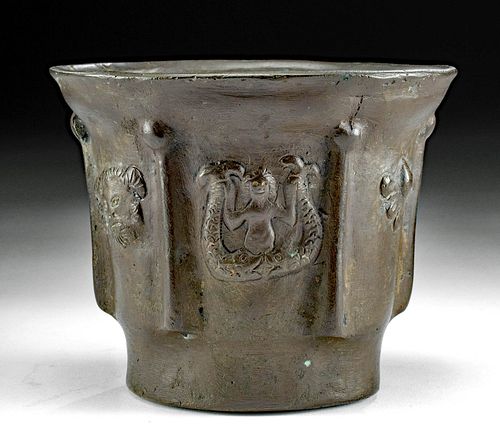16th C. European Brass Mortar w/ Sirens
Lot 100
About Seller
Artemis Gallery
686 S Taylor Ave, Ste 106
Louisville, CO 80027
United States
Selling antiquities, ancient and ethnographic art online since 1993, Artemis Gallery specializes in Classical Antiquities (Egyptian, Greek, Roman, Near Eastern), Asian, Pre-Columbian, African / Tribal / Oceanographic art. Our extensive inventory includes pottery, stone, metal, wood, glass and textil...Read more
Categories
Estimate:
$2,400 - $3,600
Absentee vs Live bid
Two ways to bid:
- Leave a max absentee bid and the platform will bid on your behalf up to your maximum bid during the live auction.
- Bid live during the auction and your bids will be submitted real-time to the auctioneer.
Bid Increments
| Price | Bid Increment |
|---|---|
| $0 | $25 |
| $300 | $50 |
| $1,000 | $100 |
| $2,000 | $250 |
| $5,000 | $500 |
| $10,000 | $1,000 |
| $20,000 | $2,500 |
| $50,000 | $5,000 |
| $100,000 | $10,000 |
| $200,000 | $20,000 |
About Auction
By Artemis Gallery
Oct 7, 2021
Set Reminder
2021-10-07 10:00:00
2021-10-07 10:00:00
America/New_York
Bidsquare
Bidsquare : Exceptional Antiquities Ethnographic Fine Art
https://www.bidsquare.com/auctions/artemis-gallery/exceptional-antiquities-ethnographic-fine-art-7537
Museum-worthy examples of Egyptian, Greek, Roman, Etruscan, Near Eastern, Far East / Asian, Pre-Columbian, African / Tribal, Oceanic, Native American, Spanish Colonial, Fossils, Ancient Jewelry, Fine / Visual Arts, so much more! Artemis Gallery info@artemisgallery.com
Museum-worthy examples of Egyptian, Greek, Roman, Etruscan, Near Eastern, Far East / Asian, Pre-Columbian, African / Tribal, Oceanic, Native American, Spanish Colonial, Fossils, Ancient Jewelry, Fine / Visual Arts, so much more! Artemis Gallery info@artemisgallery.com
- Lot Description
Western Europe, Renaissance period, ca. 16th to 17th century CE. An impressive cast-brass mortar of hefty form decorated with Classical iconography. The elegant vessel exhibits straight walls that flare out to a wide mouth with a rolled rim, all sitting upon a circular foot. Lovely relief decorations adorn the exterior of the dish, presenting a pattern of 2 sirens, 2 goat or ram heads, and 2 palmettes or scallop shell motifs, each separated from one another via vertical buttresses. The fascinating sirens both display bare chests with legs comprised of 2 fish with upward pointing tails. Mortars like this example were commonly used in apothecaries for grinding various ingredients. Size: 5.3" in diameter x 4.4" H (13.5 cm x 11.2 cm)
As the Renaissance was named for its rebirth of Classical culture, the imagery on this mortar is heavily inherited from ancient Greece and Rome. First, hailing from Greek mythology and notably mentioned in Homer's Odyssey, the sirens were dangerous creatures, whose enchanting music and singing voices lured sailors to shipwreck on the rocky coast of their island. Though represented as birds with the heads of women in Greek art, their depiction transformed to that of a mermaid figure, as seen here, during the Medieval period. The goat or ram heads are another decorative motif assumed from the ancient world. The heads of goats frequently adorned Roman architecture and were associated with the Roman god Bacchus (Greek Dionysus), god of wine and nature, and with the revels of the satyrs. Last, the palmettes, known as anthemia (singular anthemion) in the Classical world, were a typical embellishment painted on Greek pottery, as well as commonly used in Roman architecture. During the Renaissance, palmettes took the form of the inside of half of a scallop shell and became associated with the Roman goddess of love, Venus (Greek Aphrodite), and the god of the sea, Neptune (Greek Poseidon).
Provenance: private Randolph, New Jersey, USA collection
All items legal to buy/sell under U.S. Statute covering cultural patrimony Code 2600, CHAPTER 14, and are guaranteed to be as described or your money back.
A Certificate of Authenticity will accompany all winning bids.
PLEASE NOTE: Due to recent increases of shipments being seized by Australian & German customs (even for items with pre-UNESCO provenance), we will no longer ship most antiquities and ancient Chinese art to Australia & Germany. For categories of items that are acceptable to ship to Australia or Germany, please contact us directly or work with your local customs brokerage firm.
Display stands not described as included/custom in the item description are for photography purposes only and will not be included with the item upon shipping.
#167682Expected surface wear with abrasions to interior and some minor nicks throughout, all commensurate with age and use. Otherwise, intact and excellent with nice patina.Condition
- Shipping Info
-
All shipping is handled in-house for your convenience. Your invoice from Artemis Gallery will include shipping calculation instructions. If in doubt, please inquire BEFORE bidding for estimated shipping costs for individual items.
-
- Buyer's Premium



 EUR
EUR CAD
CAD AUD
AUD GBP
GBP MXN
MXN HKD
HKD CNY
CNY MYR
MYR SEK
SEK SGD
SGD CHF
CHF THB
THB















